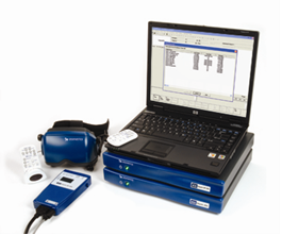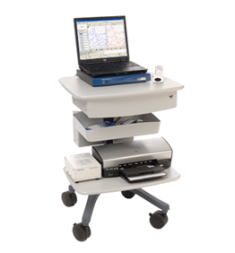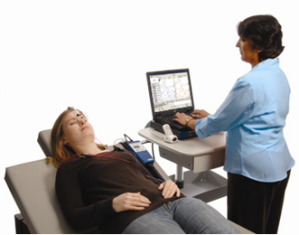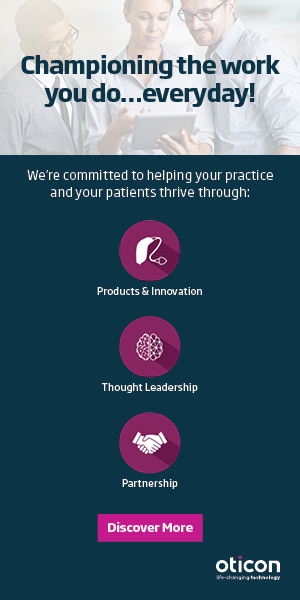Interview with Wendy Crumley, Product Manager, GN Otometrics

Wendy Crumley
Carolyn Smaka: Today I am speaking to Wendy Crumley, Otometrics product manager for the evoked potential and balance lines. Welcome Wendy, and thank you for your time today.
Wendy Crumley: Thank you for having me, Carolyn.
Smaka: Wendy, can you tell me about your background?
Crumley: I trained as an audiologist at the University of Texas, Dallas, at the Callier Center. I started off as a pediatric audiologist doing newborn screenings, later seeing infants through diagnostic testing and hearing aid fitting. After the Callier Center, I worked with OZ Systems the state of Texas on the Sounds of Texas project, which is their newborn hearing screening program. After that, I changed focus completely and worked with BioLogic systems for 5 years. From there I moved to work where I am now, GN Otometrics. Initially I was working half the time in research and development, spending the other half as an audiologist offering support to customers. Later, I moved into product management. Currently, I am the product manager for the entire ICS line, which includes the Chartr EP 200, the Chartr 200 VNG/ENG, system, caloric irrigators, Frenzel lenses, and other new products on the evoked potential and balance side of Otometrics.
Smaka: What a diverse background you have. I have always thought that product management was a neat role for an audiologist.
Crumley: It's a lot of fun, especially when you work with a great team like I do. Our team is really receptive to feedback from the field, and makes enhancements to software quickly based on that feedback. Fortunately we don't need to concentrate so much on bug fixing, although we do that if needed, but we focus on "it would be great if it did this," kind of feedback. We essentially grant the wishes of those who are using our products. I think the other exciting thing about being a product manager is being able to work with key opinion leaders;seeing what's new on the forefront of research and technology, and then bringing the fruits of that research to market. It's an exciting and interesting job.
Smaka: How is your team able to respond quickly to requests for software changes?
Crumley: The secret is having a very good documentation system and the willingness to change. The head of our software team Cindy McElligott, is excellent at documenting the comments we receive regarding software. We have a whole system that houses this kind of feedback, and we keep a running list of comments and requests. Anytime we're thinking about making a change to the software of a particular product, we go through the list of comments we have received, and see if there is anything else we can add while we're working on it. For example, right now we're working on putting ASSR into the new EP 200 box and, at the same time, we go through the feedback that has been documented and see if there is anything else we can add or modify while we're working on it. We're usually able to fill quite a few requests in one project. This is important to us because our service contracts on the ICS line include software updates. That gives us more incentive to update features that the user wants, rather than having a stagnant product that never changes. In return, the customer sees a return on their investment.
Smaka: Tell me a bit about the new EP system from Otometrics. How does the Chartr EP 200 differ from the Chartr EP?
Crumley: The ICS Chartr EP 200 is an improved version of the original Chartr EP system. The first thing customers will notice is how much smaller and more portable the Chartr EP 200 is. The original Chartr EP had all the boards installed in a tower computer, which wasn't portable. Considering a lot of people now are testing evoked potentials in the NICU, newborn nursery, operating roon or at bedside, portability is very important. When we redesigned the hardware we made it much more compact. The two components of the hardware, excluding the laptop, are the main box and the preamp, both of which have been slimmed down considerably to increase portability.
The other nice thing about the hardware box is it is the exact same size as our Chartr 200 VNG/ENG box. This is convenient for people who are doing work ups that involve evoked potentials as well as vestibular testing. The boxes stack on top of each other and the whole set up is compact. The Chartr 200 and the Chartr EP 200 can also share the same database if a user has both systems. This is helpful and time saving when a patient is having a work-up that involves both systems.
The preamp is roughly the size of a VHS tape. What's really nice about the preamp, aside from its small size, is that it has a display on the front of it that allows the user to check the impedance on the preamp as well as on the laptop. This can eliminate straining to see the impedance displayed on the laptop while the user is working with a patient. Another feature is the remote control, which allows the user to start the test or the impedance check without being near the laptop. This is helpful when testing a baby or any patient that needs extra attention or where a quick set up is important. The user doesn't need to go back to the computer to find out if the impedance is good or to start the test because the display is on the preamp and the test can be controlled via remote. It's very convenient.
The system includes protocols for ABR, EcochG, middle latency, and late latency, with the option of adding P300. Pending FDA approval, we're going to be incorporating ASSR and VEMP. These two options have been released internationally and are widely used in those markets, and we're hoping that the U.S. will follow relatively shortly.
Smaka: You mentioned two key benefits of this system - portability and convenience. It seems like a very easy to use system.
Crumley: Yes, it definitely is easy to use. In developing this system, we talked to current customers and our sales force and asked why they like the Chartr system. The one thing people always mentioned was that the software was intuitive;it was very easy to figure out how to use and to understand. The whole concept is that the software is very simple to learn;most people can just pick it up and start using it with very little training.
In the software there are three easy to use tabs;a review tab, a new test tab, and a settings tab. The new test tab is where the user would pick the protocol for the test that was to be run. The user would access the review tab to look at previously collected data. The settings tab gives the user a central location to find the parameters that are most likely to be changed during testing such as the test ear, intensity, rate, and polarity. The software makes it very easy and quick to make changes during a test.
The display options in the software also offer a lot of flexibility that contributes to ease of use. The software allows the user to display up to 20 waveforms per page and allows the user an unlimited number of pages. This makes it very simple to keep data organized, and to reorganize data as needed. For example, a user may want to display the results of click stimuli on one page and tone burst on another page. The user could also choose to have a page of air conduction results and a page of bone conduction. There is a lot of flexibility to organize data and keep everything neat and easy to interpret.
Ease of use and good workflow is something everyone in the industry strives for - a system may have some great features, but if the day to day use is difficult, most users will turn to another system. Ease of use and portability are key to having a system that can be used successfully.
Smaka: When was the Chartr EP 200 released?
Crumley: In the United States, it was released in February.
Smaka: What kind of feedback have you received from your customers so far?
Crumley: We've had excellent feedback. Everybody agrees the system is very easy to use. The majority of the protocols people use are set in the software already;if they want to edit or create their own they can, but it's very easy to pick up the system and get started. We've also had a lot of courses on AudiologyOnline and plan on adding some more to help users make the most of our software. Otometrics is very focused on education to help the user learn more about electrophysiology in general. Additionally, the manual for the Chartr EP 200 is very good. It shows pictures of all the montages, and offers simple and clear instructions that make the set up easy, even for users who not well versed in evoked potentials.
Smaka: You mentioned that people can use the system easily with very little training, but you offer trainings as well, correct?
Crumley: Yes, we love doing the courses on AudiologyOnline (www.audiologyonline.com/otometrics) since we are a global company. I get so excited when I'm teaching a course in Asia or Europe, and I ask how many have been on AudiologyOnline, and a number of attendees raise their hands! AudiologyOnline allows an instant global attendance that is not possible in face-to-face seminars. It also allows questions, ideas, and other types of feedback to be shared between professionals who would normally not ever get to meet in person.
I have found that professionals across the globe who are really determined to learn more about electrophysiology, balance, and even hearing aid fittings to their patients typically read a lot of the English language journals. So while English may not be the primary language of everyone in a seminar, whether on AudiologyOnline or in a face to face meeting, many professionals receive a good portion of their audiology education in English.
In addition to online trainings, we have four in-house trainings a year in our office in Schaumburg, Illinois. The trainings last for two days;one day is on evoked potentials and one day is VNG/ENG, and both have hands-on portions. This class is also offered, with the same format, twice a year in the UK. We are fortunate to have key opinion leaders like Dr. Kamran Barin, who lectures for Otometrics, giving us the opportunity to offer theory classes which include practical know-how in the US and as we see a need in other countries as well, such as UK, Singapore, Brazil, China, Australia and a number of others.
Smaka: What challenges are presented when a product like this is released worldwide?
Crumley: It's interesting because you have to learn what key features are important to each country your product is offered in. The world does not use one shared protocol, so you have to build a system that's very flexible. Ideally a system should automatically meet the needs of 90% of the market, and be able to be easily adjusted for the other 10%. A simple example can be found when comparing the newborn hearing screening programs in the United Kingdom with the ones in the United States. In the UK, the newborn hearing screening programs must have very specific diagnostic protocol. Their protocol requires a higher stimulus rate than in the US, and they collect data using one channel. In the US newborn hearing screening protocol recommends using two channels and a lower stimulus rate. The ability to be flexible enough to easily accommodate those kinds of differences is important.
Smaka: Where can people look if they want to learn more about the Chartr EP 200 or any other Otometrics products?
Crumley: I would refer people to www.otometrics.com for information on Otometrics products and www.otometrics.com/chartrep for more information specifically on the ICS Chartr EP 200.
Smaka: Thank you, Wendy. Wishing you much success with this new system.
Crumley: Thank you, Carolyn.
About Otometrics
Copenhagen-based Otometrics is the world's leading manufacturer of hearing and balance instruments and software. Its North American headquarters is in Schaumburg, Illinois. The company has solutions that range from infant-screening applications and audiologic diagnostics to balance testing and hearing-instrument fitting. More information about Otometrics can be found at www.otometrics.com or the Otometrics Web Channel at Audiology Online.

